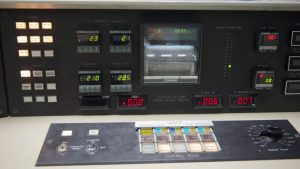One of the most unique resources the University of Utah offers is a nuclear reactor housed in the Merrill Engineering Building (MEB) on the northwest corner of campus. Though this reactor does not generate electricity to power the U’s buildings, is used extensively in student and faculty research.
This is the only nuclear reactor in Utah. Like all nuclear reactors, it functions by nuclear fission, the splitting of neutrons into smaller pieces.
The U’s reactor is used to analyze material samples through neutron activation analysis. This determines the elemental makeup of materials by causing the sample to form radioactive isotopes. Neutron activation analysis is often preferred over mass spectrophotometry because it preserves the sample. Students at the U have used the reactor to study mercury content in material samples from the salt flats.

Construction of the nuclear reactor began in 1972, led by Dr. Gary Sandquist, a professor at the U. The reactor went critical for the first time in 1975, meaning it became self-sustaining by using one nuclear fission reaction to cause another in a chain of reactions.
Ryan Schow, a nuclear engineering PhD student, is supervisor of the nuclear reactor. In addition to offering tours of the facility, Schow teaches increasingly popular classes involving the reactor. Schow also helps students earn reactor operator licenses from the Nuclear Regulatory Commission (NRC).
Students are able to obtain a minor, MS, or PhD in nuclear engineering, a program administered by the Civil and Environmental Engineering department. Unfortunately, no BS program is available at the moment.
The radiation levels of the reactor are carefully monitored, though Schow says they are very low and it is not dangerous to stand near the reactor.
Nuclear safety culture is a priority at the U. Before handling the reactor, students are taught the correct protocol, as well as how to identify and correct hazards in the lab. The U is the only university worldwide that has a nuclear safety culture.
“A lot of the accidents in the history of nuclear power could have been prevented if they’d had better safety culture,” Schow said.
There are also safety mechanisms directly tied to the reactor, including a feature that turns off the equipment if the power levels become higher than 100 thermal kilowatts.

In addition to these safety features, there are various alarms connected to the reactor. Police response times to the alarm are tested monthly and FBI and bomb squad drills have also been held.
The reactor is filled with thousands of gallons of water which have not been drained from the reactor since the 1970s. This water functions as a radiation shield by absorbing the majority of the energy the reactor gives off and slowing down neutrons.
When nuclear reactors are decommissioned, containment materials must be handled in a specialized manner.
“The concrete in the walls becomes [unintentionally] activated over 40 to 60 years of being near the reactor,” Schow explained. “When they decommission the reactor, you have to pay millions of dollars to dispose of the low-level radioactive waste that was created.”
Civil engineering students at the U are working to create a solution for this problem by developing concrete that won’t become activated after long term exposure to the reactor.
k.wang@dailyutahchronicle.com
@karissawang

